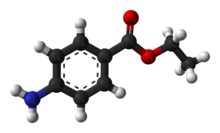- Benzocaine
-
Benzocaine 

Systematic (IUPAC) name ethyl p-aminobenzoate Clinical data Trade names Anbesol, Cepacol, Lanacane AHFS/Drugs.com monograph Pregnancy cat. C(US) Legal status ? Routes Topical Identifiers CAS number 94-09-7 
ATC code C05AD03 D04AB04, QN01AX92, N01BA05, R02AD01 PubChem CID 2337 DrugBank APRD00539 ChemSpider 13854242 
UNII U3RSY48JW5 
KEGG D00552 
ChEBI CHEBI:116735 
ChEMBL CHEMBL278172 
Chemical data Formula C9H11NO2 Mol. mass 165.189 g/mol SMILES eMolecules & PubChem  (what is this?) (verify)
(what is this?) (verify)Benzocaine is a local anesthetic commonly used as a topical pain reliever, or in cough drops. It is the active ingredient in many over-the-counter anesthetic ointments (e.g., products for oral ulcers of Anbesol by Pfizer, Kank-a by Blistex, and Orabase B and Orajel by Church & Dwight). It is also combined with antipyrine to form A/B Otic Drops, (Brand name Auralgan) to relieve earpain and remove earwax.
Contents
Chemical properties
Benzocaine is the ethyl ester of p-aminobenzoic acid (PABA); it can be prepared from PABA and ethanol by Fischer esterification or via the reduction of ethyl p-nitrobenzoate. Benzocaine is sparingly soluble in water; it is more soluble in dilute acids and very soluble in ethanol, chloroform and ethyl ether. The melting point of benzocaine is 88-90 degrees Celsius,[1] and the boiling point is about 310 degrees Celsius.[2] The density of benzocaine is 1.17 g/cm3.
History
Benzocaine was first synthesised in 1890 by a German chemist named Eduard Ritsert, in the town of Eberbach[3] and introduced to the market in 1902.[4]
Mechanism of action
Pain is caused by the stimulation of free nerve endings. When the nerve endings are stimulated, sodium enters the neuron, causing depolarization of the nerve and subsequent initiation of an action potential. The action potential is propagated down the nerve toward the central nervous system, which interprets this as pain. Esters of PABA work as a chemical barrier, stopping the sodium entering the nerve ending.
Side effects
Allergic reactions occur with ester local anaesthetics (like benzocaine) because of the PABA structure.
Benzocaine also is a well-known cause of methemoglobinemia. Because it may be used in topical creams with a concentration as much as 20%, it is not difficult to administer a dose sufficient to cause this problem.
Other risks
Over-application of oral anesthetics such as Anbesol can increase the risk of pulmonary aspiration by relaxing the gag-reflex and allowing regurgitated stomach contents or oral secretions to enter the airway. Applying an oral anesthetic and consuming beverages before going to bed can be particularly hazardous. The U.S. Food and Drug Administration notified healthcare professionals and patients that FDA continues to receive reports of methemoglobinemia, a serious and potentially fatal adverse effect, associated with benzocaine products.[5]
Other uses
Benzocaine has become the most commonly encountered sophisticated 'bulking agent' for cocaine in the UK.[6] It is being imported in barrels, often 25 kilograms, and sold within the domestic cocaine market where it is used to at least double the weight of imported cocaine. This cocaine is often then repressed into a block and stamped with a logo to suggest it has been freshly imported to the UK from source or transit locations. Benzocaine is visually very similar to cocaine and therefore does not detract from the appearance of quality. One of the other features of this substance is that it remains within the cocaine when it is subjected to Crack manufacture and has subsequently been attributed the slang name of 'magic'. Previous less compatible and inert cutting agents are evaporated within the process and therefore expose extensive adulteration. Benzocaine increases the volume of crack produced and disguises the lower quality or purity as it binds to the cocaine becoming visually indistinguishable within the Crack. The influence of benzocaine has been a significant contributor to the remarkable price increase in high purity cocaine in the UK since 2007 and the very low street quality when sold in heavily adulterated grams.
Benzocaine is used as a key ingredient in numerous pharmaceuticals:
- Over the counter throat lozenges such as Cepacol, Life Brand Oral Anaesthetic.
- Some glycerol-based ear medications for use in removing excess wax as well as relieving ear conditions such as Otitis Media and swimmers ear.
- Some previous diet products such as Ayds.
- Some condoms designed to prevent premature ejaculation. Benzocaine acts to desensitize the penis, and theoretically allows an erection to be maintained.[7][8]
Benzocaine is used in abalone aquaculture. The strong muscular foot which the abalone use to hold on to the rocks in the wild makes handling the animals difficult. Abalone farmers use benzocaine to mildly anaesthetise them, resulting in the animals loosening their tight grip on the substrate. This enables the farmers to more easily remove them and move them around the farm.
Misconceptions
In Philip K. Dick's book A Scanner Darkly, Jim Barris, one of the main characters attempts to extract pure cocaine out of a bottle of sunburn spray by freezing it, claiming that benzocaine is simply an industry name for cocaine,[9].
In reality, cocaine is significantly different from benzocaine. [10]
References
- ^ "Monographs: Pharmaceutical substances: Benzocainum - Benzocaine". The International Pharmacopoeia. http://apps.who.int/phint/en/d/Jb.6.1.62/#docfirsthighlight. Retrieved 29 September 2009.
- ^ D'Ans-Lax, Taschenbuch für Chemiker und Physiker, 4. Auflage, Band 2, Springer Verlag 1982, ISBN 3-540-12263-X
- ^ "100 years of Dr. Ritsert". Dr. Ritsert Pharma. http://www.ritsert.de/index.php?option=com_content&task=view&lang=en&id=13&Itemid=27. Retrieved 14 March 2010.
- ^ Harry Auterhoff, Lehrbuch der pharmazeutischen Chemie, Wissenschaftliche Verlagsgesellschaft Stuttgart, 1968
- ^ http://www.drugs.com/fda/benzocaine-topical-products-gels-liquids-risk-methemoglobinemia-12941.html
- ^ "How cutting drugs became big business". BBC. 7 September 2010. http://www.bbc.co.uk/news/magazine-11177126. Retrieved 9 September 2010.
- ^ "'Longer-lasting' condom launched". BBC News. 17 June 2002. http://news.bbc.co.uk/1/hi/health/2049202.stm.
- ^ Garner, Dwight (15 December 2002). "Endurance Condoms". The New York Times. http://www.nytimes.com/2002/12/15/magazine/15ENDU.html.
- ^ Page 47
- ^ [citation needed]
External links
- U.S. Food and Drug Administration investigation of the possible adverse effects of benzocaine mouth and throat sprays.
- Safety data from the Chemistry Department at Oxford University.
Vasoprotectives (C05) Antihemorrhoidals for topical use corticosteroids (Hydrocortisone, Prednisolone, Betamethasone, Fluorometholone, Fluocortolone, Dexamethasone, Fluocinolone acetonide, Fluocinonide)
local anesthetics (Lidocaine, Tetracaine, Benzocaine, Cinchocaine, Procaine, Oxetacaine, Pramocaine)
other (Tribenoside)Antivaricose therapy heparins or heparinoids for topical use (Organo-heparinoid, Sodium apolate, Heparin, Pentosan polysulfate)
sclerosing agents for local injection (Monoethanolamine oleate, Polidocanol, Invert sugar, Sodium tetradecyl sulfate, Phenol)
other (Calcium dobesilate)Capillary stabilising agents bioflavonoids (Rutoside, Monoxerutin, Diosmin, Troxerutin, Hidrosmin) - other (Tribenoside, Etamsylate)Antipruritics (D04) Antihistamines for topical use Anesthetics for topical use Anesthetics: Local anesthetics - primarily sodium channel blockers (N01B) Esters Esters of aminobenzoic acidAmylocaine • Benzocaine • Butacaine • Butamben • Chloroprocaine • Dimethocaine • Meprylcaine • Metabutoxycaine • Orthocaine • Propoxycaine • Procaine (Novocaine) • Proxymetacaine • Risocaine • TetracaineEsters of benzoic acidAmides Articaine • Bupivacaine # /Levobupivacaine/Ropivacaine • Carticaine • Cinchocaine • Etidocaine • Lidocaine # • Mepivacaine • Prilocaine • TrimecaineCombinations Throat preparations (R02) Antiseptics Acriflavinium chloride • Ambazone • Benzalkonium • Benzethonium • Cetrimonium (bromide/chloride) • Cetylpyridinium • Chlorhexidine • Chlorquinaldol • Dequalinium • Dichlorobenzyl alcohol • Hexamidine • Hexylresorcinol • Myristyl-benzalkonium • Oxyquinoline • Phenol • Povidone-iodineAntibiotics Local anesthetics Other
Wikimedia Foundation. 2010.
